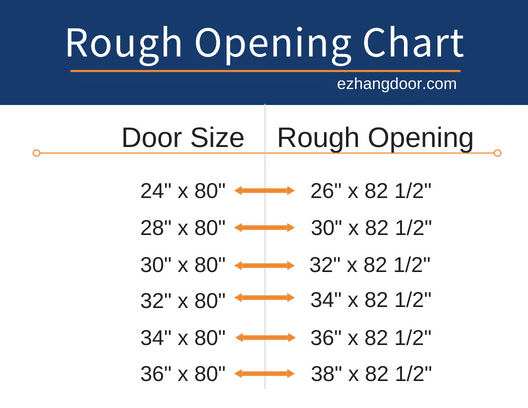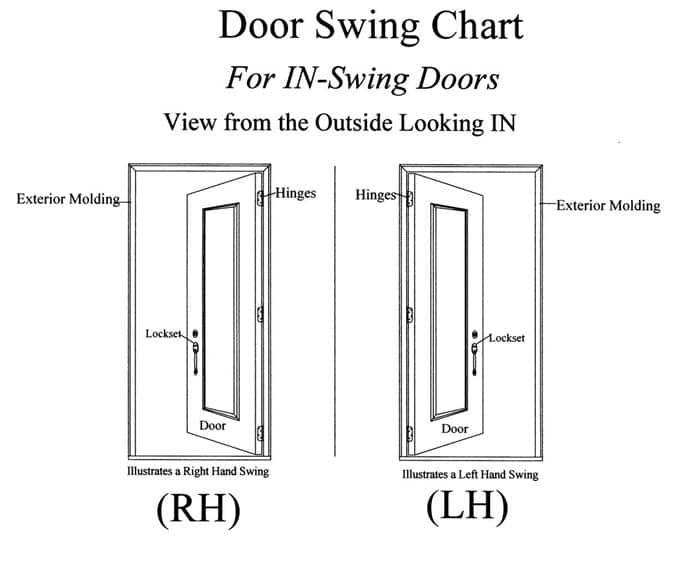What Size Should I Frame My Rough Opening?
You should add 2-1/2″ to the height of the actual door. This will give you room to space the door frame off of the sub-floor. Now all you need to know is how to properly frame your door rough opening.
So, if you have a bedroom door that is 30″ wide (which is considered a 2/6 or 2′-6″ door) just add 2″ to the width and frame it 32″ wide. The height is 80″ (which is considered 6/8 or 6′-8″) add 2-1/2″ to the actual door height and frame it 82-1/2″ high.
Rough Opening Chart (in feet):
2/0 door = 2/2 R.O.
2/4 door = 2/6 R.O.
2/6 door = 2/8 R.O.
3/0 door = 3/2 R.O.
* Note: All R.O. widths are 2″ wider and 2-1/2″ taller (82 1/2″) high
Why Does the Opening Need to be Bigger than the Door and its Frame? Three Reasons:
1. Room to adjust the door and the frame in the opening. Wall framing is called rough framing for a reason. Not all rough openings are completely plumb and square. Leaving this extra space allows you to perfectly plumb, level and square your door installation.
2. Next, not all doors are exactly the same size. The sizes of the door will vary by manufacturer. Normally this isn’t much, but if your rough opening was tight, or exactly the size of the door and the jamb, you may not get the door to function properly without having room to adjust.
Door Installation Quick Tip
If you are going to carpet the floor, shim the door jambs off the floor about 3/8″. This will allow
Another advantage would be, if your floor isn’t level, it will allow you to adjust your latch side up or down independently of the hinge side.
Check out this video for a visual example on how to install a door.
Rough Opening Sizing Questions
What size rough opening do I need for a double door?
For a normal double door without an astragal, the rough opening is normally 2 times the actual door width, plus 2 inches.
Are interior and exterior rough openings the same size?
Yes and no. Most standard interior and exterior doors will have the same rough opening width, but some manufacturers differ in the height between the two. It’s always best to verify the recommended RO from the manufacturer.
Is the rough opening the same size for all door manufacturers?
For standard interior doors, most manufacturers will require the same RO size. However, for sliders, french, and atrium doors, the rough opening size will vary.
My rough opening is too big, what should I do?
If your rough opening is too big, a simple solution is to add a 1×3 furring strip to one or both sides of the opening.
My rough opening is too tall for the top bracket, what should I do?
If your rough opening is too tall, add a 1 x 3 block to the top of the jamb to attach the bracket to.
What if my rough opening is the same size as my door?
If the vertical plane of the wall is mostly plumb and the door fits in the hole, you still may be able to use the brackets. Just be sure to use the single arrow markings on the brackets for screw placement, as it places the screws closest to the outermost part of the wall. The outermost part of the wall is where the drywall is installed, so you will be able to cut notches in the drywall to make room for the screw heads.
More Rough Opening Tips
- Verify the width and height of the door frame are each 1/2″ smaller than the rough opening width/height.
- Verify the rough opening is square. The diagonal measurements should be the same. Maximum allowable deviation from
square is normally 1/4″.
- Verify the rough opening is level and plumb. The maximum allowable deviation is 1/8″ to 1/4″.
- The rough opening sill must not be crowned or sagged.
- Minimum double studs should be used at all rough openings.
- The exterior face of the rough opening must be in a single plane.
Determining the Swing or Handing of a Door
What’s the easiest way to determine the swing or hand of a door? Here are a couple of options. You can decide what’s easier for you to remember.
Step in the doorway with your back to the hinges. You will be standing sideways in the opening, looking at the opening where the door latches. If the door and hinges are on the left side, it is a left-hand door. If the door and hinges are on the right side, it is a right-hand door.
Another way:
Always picture this from the inside, or the room the door swings into. Looking and facing the door, if the door-knob is on the left side of the door, it is a left-handed door. If the knob is on the right, it would be a right-handed door.
You can also determine the swing of the door based on whether you’re replacing a door vs. installing a new one.



